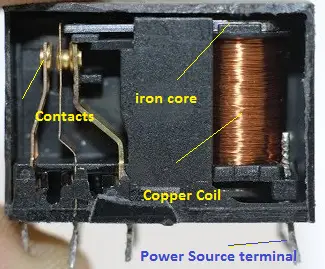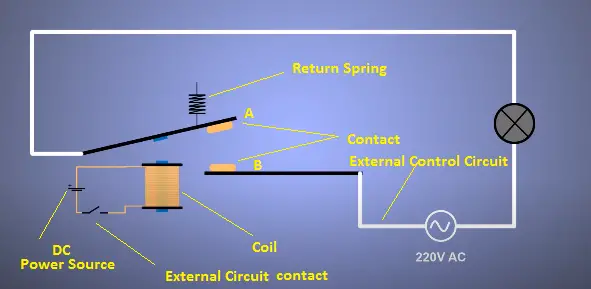What is Relay In electrical?
Electrical Relay is nothing but an electromechanical switch that is used to control an electrical/electronic circuit locally or remotely. But latest solid-state relays use electronics components such as the transistor, diode to control the circuit without physical contact.
Construction of relay:
Construction front, electromagnetic coil, contact, iron core and power source are the important parts of a relay. Here electromagnetic coil is made up of thin copper wire wound in magnetic material and it will be connected to a power source. An iron core will be kept inside or outside of the electromagnetic coil.

The power source will be controlled by the external circuit. It can be DC or AC. In generally relays are designed to operate both direct and alternating current up to 1.5V to 690V.
The contact will be connected with the external circuit. The contact made up of silver alloy to withstand the high current breaking. Also, it has the ability to withstand on high arcing temperature upto 3000°C.
According to our requirement, the selection of relay contact can be varied such as NO or NC. NO, and NC indicates the relay’s default position. It means the relay should be either Normally Open or Normally closed condition. Mostly both the type of relays are used.
Relay connection Diagram:
Look at the figure, In this, our ultimate goal is blowing the lamp.

The figure consists of two circuit diagrams such as relay internal circuit and the external control circuit.
In the relay circuit, the electromagnetic coil is connected in series with the power source, external contact, relay contact.
The external control circuit consists of 230 volts AC power source is connected in series with the Lamp and relay’s contact.
The relay internal and external circuit does not have any electrical contact by they have mechanical contact which means, the relay circuit is having the ability to control the external circuit by operating the relay circuit’s coil.
Relay Operating Principle:
All electromagnetic relays are working based on Faraday’s Electromagnetic Induction. For instance, if we close the external circuit contact, the current start flows from power source to coil.

Then the coil becomes electromagnet and which attracts the iron core placed inside the coil. Also, the iron core pulls the relay contact terminal A. Due to this, A and B will be connected.
Then the current starts flowing in the external control circuit. Finally, the Lamp blows.
Frequently Asked Questions:
Do we need relay coil protection?
Actually Not required, but in the very rare instance the coil will get fail due to insulation failure, so the coil act as a short circuit to the power source, during that time, the power source protection trips the circuit, hence any individual relays do not require any protection circuit.
How much current relay can consume?
Relay coil input current is directly depending on the size of the relay, practically it is small, hence the relay current will be fewer milli ampers.
Does relay contact get corrode?
No, since MOC (Material of construction) is sliver alloy, which will be coated with nickol. Nicole does not react with the oxidation. Hence relay contact will not corrode.
Can we rewind the relay coil?
Yes, We can rewind the relay coil by counting the number of turns and thickness of the coil.
Does relay have polarity concern?
No for electromagnetic coils and yes for Solid State Relays. Since electromagnetic coils are made up of copper wire and as we know copper does not have any polarity, therefore electromagnetic relay can be connected without polarity concern.
But Solid-state relays are made up of transistors and diodes, hence reverse polarity damages the relay. So you have to put an eye on the solid-state relays.

Thanks for the great insight , pls send more pages for convenience of downloading